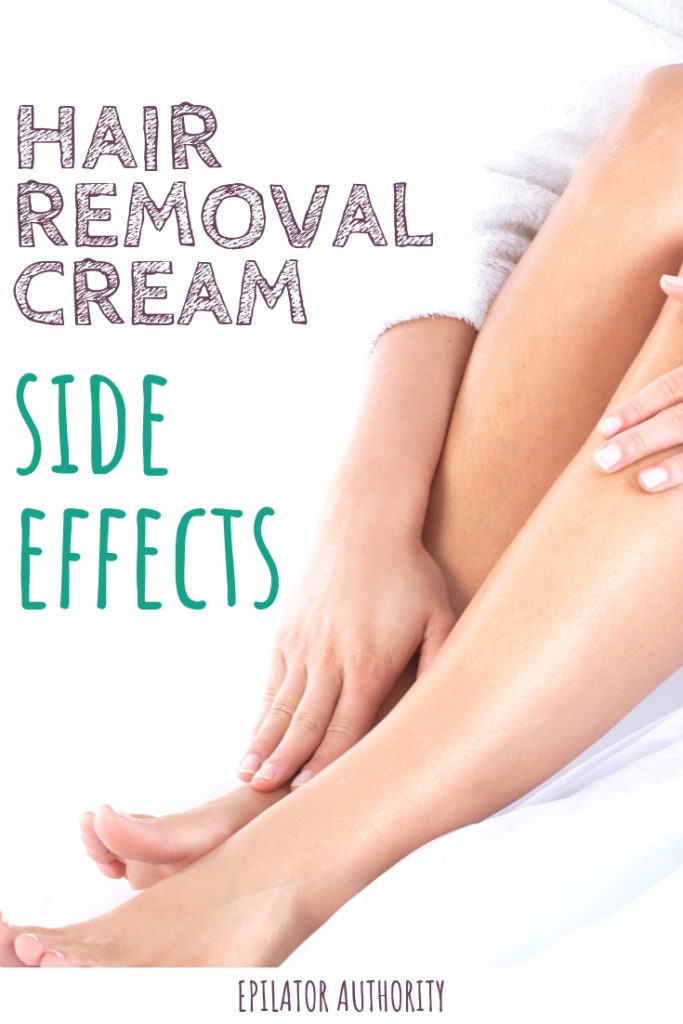I loved the idea of using hair removal creams like Nair or Veet for the hair on my face as well as my legs. It’s such a simple and straightforward process and my hairs grow back less densely afterward. Unfortunately, I’ve found out first hand that there are many side effects that can sometimes outweigh the benefits of using these creams on the face or body, depending on how sensitive your skin happens to be.
What are the side effects of using hair removal cream on the face or body? When using hair removal creams on the face or body, the most common side effect is mild skin irritation and pain. Other possible side effects include allergic reaction, burns, odors, skin darkening, scars, ingrown hairs, folliculitis, eye irritation, and possible poisoning if accidentally ingested.
Some of these side effects sound a little scary, but it’s important to remember that most are rare and temporary. Once you have an understanding of all the side effects and how they are caused, you can take several steps to prevent them the next time you use hair removal cream.
Mild Skin Irritation and Pain
Skin irritation is the most common side effect of hair removal creams on the face and body. The harsh chemicals in these creams irritate the skin. Burning, redness, and itching are normal skin reactions to these chemicals.
While the cream is still on the skin, you may feel a mild stinging or burning sensation. Once the cream is removed, this feeling will usually subside immediately or within a few hours.
The skin may also have some redness after application that usually goes away within a few hours.
Allergic Reaction
Although some irritation is normal with hair removal creams, some people will develop an immune response to the chemicals in the cream, resulting in a more severe skin irritation called contact dermatitis. This can happen during the first application or you can develop an allergy after multiple applications.
With contact dermatitis, you may see a reaction immediately or it may be delayed, showing up minutes, hours, or days after the cream is removed.
With an allergic reaction from hair removal cream, you may have a rash with any of the following symptoms:
- itchiness
- redness
- dry, scaly, or cracked skin
- blisters
- bumps
- oozing and crusting
- swelling
- burning
- tenderness
Contact dermatitis will usually clear up on its own within two weeks as long as you avoid using the hair removal cream again.
Chemical Burns
Chemical burns are a major hazard when using these creams. Your skin is made of the same substances in hairs. So the cream will eventually break down your skin like it breaks down hairs if you leave it on too long. This can cause first or second-degree chemical burns.
Signs of a chemical burn include redness, extreme pain, and blisters. They usually resolve within a few weeks but may need medical treatment.
Strong Odors
The chemicals in hair removal creams have strong, unpleasant odors. Companies have tried hard to mask these smells, but it’s pretty much impossible. You will have to deal with the smells while using the creams and some odor may linger on your skin for a few hours after application.
Another concern with the odors is that some of the chemicals emit fumes that can irritate the lungs and may be too strong for people with existing lung and breathing issues.
If the fumes bother you or affect your breathing, get yourself to some fresh air.
Darkening of the Skin and Scarring
When hair removal creams inflame or burn skin, a dark patch of skin can develop. This is called inflammatory hyperpigmentation. It is more common in people with darker skin types. Fortunately, it is temporary and will eventually fade.
Skin irritation, burns, and allergic reactions may also cause wounds and blisters that may result in hyperpigmentation or scars.
Ingrown Hairs and Folliculitis
With any hair removal method, ingrown hairs and folliculitis are possibilities.
Ingrown hairs happen when hairs get trapped under the skin when they are growing back.
Folliculitis is inflammation of the hair follicle. When using hair removal creams, folliculitis may occur if ingrown hairs cause irritation or become infected. This may cause swelling, pain, itching, and scars.
The good news is that hair removal creams don’t typically damage the skin and hair follicles like other hair removal methods, ingrown hairs and folliculitis is usually less likely to happen. In fact, many dermatologists recommend hair removal creams to people who have problems with ingrown hairs.
Eye Irritation and Damage
When using hair removal cream on the face, you should never use it near your eyes. However, it is possible that you may accidentally get some cream near or in your eye. If this happens, serious irritation and serious eye damage can occur.
If you get cream in an eye, rinse with water for several minutes. If you are wearing contact lenses, remove them and continue rinsing.
Poisoning
Hair removal creams contain poisonous substances including sodium or calcium hydroxide (alkalis), barium sulfide, and thioglycolates.
Although unlikely, it is always possible that you may get some cream in your mouth when using it near your upper lip or chin. If this happens, you should obviously spit out the cream, rinse your mouth well, and seek medical advice.
Never, ever swallow hair removal cream. If you do swallow any cream, call 911 or poison control immediately and follow their directions.
How to Prevent Hair Removal for Face Side Effects
There are several precautions you can take that will help you avoid many of the side effects of depilatory creams:
- Do a patch test, following the directions that came with your cream. Wait at least 24 hours to see if you have an allergic reaction.
- Use hair removal cream in a well-ventilated room to reduce lung exposure to harsh fumes
- Do not use on eyebrows, ears, nose, or near eyes.
- Do not put cream on sunburned, cut, broken, or inflamed skin.
- Do not rub the cream into your skin.
- Do not leave the cream on for longer than recommended. To really be on the safe side, use it for less than recommended by doing a test on a small area every minute to see if the hair is gone or not. As soon as the hair is removed, wipe off all the cream.
- Have a wet cloth or a shower ready so you can get the cream off quickly if your skin has a reaction.
Related Questions
What are the long term effects of hair removal cream?
If you use hair removal creams regularly, your skin may become more sensitive to irritants and sunlight. You may also develop an allergy to the cream which will cause contact dermatitis.
Does hair removal cream make hair grow back thicker?
There is no evidence that hair removal cream makes hair grow back thicker. In fact, it’s more common to see hair growing back less densely and thinner after repeated use.
What’s the best hair removal cream for the face?
My pick for best hair removal cream for face hair is Nair Hair Remover Moisturizing Face Cream (click to check it out on Amazon). Nair has been around for over 50 years and they have had tons of time to perfect their forumla so it gets the best results with the lowest risk of side effects possible. This cream is also super affordable and leaves your skin exfoliated and feeling super soft.
Want to remember this? Pin this to your favorite Pinterest board so you can find it later!

References
Consumer Product Information Database: SDS For Nair Hair Remover Precision Face and Upper Lip Kit-01/21/2016
Consumer Product Information Database: SDS For Veet Botanic Inspirations Hair Removal Cream, Sensitive Formula
U.S. National Library of Medicine: Haz-map for Contact dermatitis, allergic
U.S. Food and Drug Administration: Removing Hair Safely
Institute for Quality and Efficiency in Health Care: Allergic contact dermatitis: Overview
The Indian Journal of Surgery: Shaving Versus Depilation Cream for Pre-operative Skin Preparation
